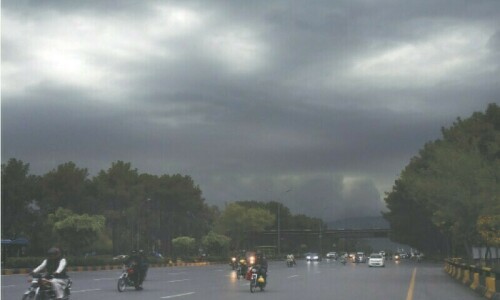
Although it is stated in the Manaqib al Arifin that at the time of the death of Rumi’s father, his teacher and tutor Burhan alDin certified his pupil’s thorough attainment in prevalent sciences and then launched him on a long course of mystical practices which continued for nine years, yet we do not find any fruits of these spiritual experiences in the life of Rumi before his encounter with the mystical and mysterious Shams of Tabriz.
Rumi now engaged himself in teaching theology and giving sermons as the learned religious teachers of his time usually did. His verdict or fatwa was sought and quoted about religious questions on which he was held to be an authority. He avoided music as the rigid puritanical orthodoxy of his time did. There is no doubt that his meeting with Shams was a turning point in his life. As to what happened when Shams and Rumi met for the first time, there exist a number of legends that are inconsistent.
According to one version, Rumi, surrounded by books and pupils, was engaged in teaching when Shams suddenly dropped in and asked him, “What are these books about?” Taking him to be a man without learning Rumi replied that the questioner could not know what they contained. At this the heap of books burst into flames. Rumi in great consternation asked him the meaning of this miraculous phenomenon. At this Shams said, “This is what you cannot understand.”
How the dervish Shams-i-Tabrizi influenced the life and work of the great Sufi poet Rumi
Another version of this legend is that Shams threw the books in a cistern of water and when Rumi was enraged at this Shams brought them out without the water having touched them; they were as dry as before. Shibli, the eminent modern writer of a book on Rumi, is evidently right in his judgment that these legends are not based on facts because Sipah Salar, who spent 40 years in intimate contact with Rumi, relates his meeting with Shams in a simple story unadorned by any legend. If anything unusual had happened, surely this friend and devotee would not have missed mentioning it.
He says that Shams was the son of ‘Ala’ alDin and was a descendant of Kaya Buzurg, an Imam of the Ismaili sect before dissociating himself from it. Shams received his education in Tabriz and then became a disciple of Baba Kamal alDin Jumdi, who introduced him to the mystic way of life. He travelled from place to place living in caravanserais, weaving girdles and selling them for bread. He was staying in a serai of Quniyah when Rumi went to see him. The impression of this mystic on Rumi’s mind was deep and lasting. Sipah Salar says that the two were closeted together for six months in Salah alDin Zarkub’s room, which none but Zarkub was allowed to enter.
Now Rumi left off teaching and preaching and spent days and nights only in the company of Shams. It was rumoured that a magician had bewitched the great divine. Rumi’s sons and disciples turned against Shams whom they considered to be a charlatan and a sorcerer. Under these circumstances Shams left Quniyah suddenly, leaving no clue about his whereabouts.
After a long time Shams wrote to Rumi from Damascus. This letter kindled the flame in Rumi’s mind again. In the meantime his disciples whose resentment had driven away Shams had repented of their conduct. Rumi’s son Sultan Walad in his Mathnawi has mentioned this incident in detail because he was deputed by his father to go to Damascus accompanied by some other disciples to persuade Shams to return to Quniyah.
It is difficult to assess the mind and character of a man who appeared from nowhere and disappeared without leaving a trace after having influenced so deeply one of the greatest religious geniuses of all times. Could a man of Rumi’s mental calibre be the subject of an abiding delusion created by a master hypnotist?
The epistle of Rumi written in verse is recorded in the Mathnawi of Sultan Walad. This letter shows how deeply Rumi had felt the pangs of separation from his spiritual guide and in what great esteem he held him. Shams accompanied this delegation and returned to Quniyah where he was received with great honour by Rumi and his disciples. It appears that Shams now meant to stay on, having allayed the suspicions of Rumi’s disciples by marrying a maid of Rumi’s house whose name was Kimiya.
A residential tent was pitched for the wedded couple in front of the family residence of Rumi. Something happened again which turned Rumi’s son ‘Ala’ alDin Chalpi against Shams and others joined him with the result that Shams disappeared now for good. Rumi’s reliable biographer Sipah Salar says only this much that Shams left Quniyah again in indignation and although Rumi sent people to search for him in various places no one could find him. But other biographers of Rumi are in full accord about the conviction that Shams was assassinated by some of Rumi’s disciples, and the author of Nafahat al-Uns mentions the name of Rumi’s son, ‘Ala’ alDin, as his murderer. The assassination or disappearance of Shams took place in about 645/1247.
It is difficult to assess the mind and character of a man who appeared from nowhere and disappeared without leaving a trace after having influenced so deeply one of the greatest religious geniuses of all times. Could a man of Rumi’s mental calibre be the subject of an abiding delusion created by a master hypnotist? The world has valued Rumi as a man of deep spiritual apprehension; a man whose religious life was rooted in a personal experience which could stand the test of reason. We find him acknowledge his debt to Shams in a thousand soulstirring lyrics.
Shams found Rumi an academic theologian and conventional preacher and converted him into an ecstatic mystic in deep personal contact with the ineffable verities of life. The prosaic Rumi was overnight turned into an ecstatic lyricist, who now found poetry and music better than philosophy and theology as vehicles for the expression of truth. Rumi identified himself so completely with Shams that the voluminous collection of his mystical lyrics is called Diwan-i-Shams-i Tabriz. In hundreds of lyrics the inspiration received from this mysterious spiritual guide is acknowledged with vibrating gratitude. The realm of mystical experience is a doubly sealed mystery to the uninitiated, but he has to accept the testimony of Rumi about it, however personal and subjective it may be, when he says with unshakable conviction that in Zarkub’s shop, where the guide and the disciple were closeted together in mysterious intimacy, he found a spiritual treasure of indescribable value and ineffable beauty, both of form and meaning.
We can say only this much that Shams must have been a man of extraordinary psychical power capable of influencing the master mind of his age, whose magnum opus of intellectualised and versified religious experience created a monument of mystical poetry in which eternal love and cosmic reason seem to have achieved perfect accord.
Rumi had no intention of either founding a new sect or initiating a new movement; his devotees and disciples, however, did form a distinctive group after his death, but they developed and perpetuated only some external observances and rituals, and degenerated into a community of whirling dervishes. A feltcap without a seam — the leaders also wrapping a turban round it and wearing voluminous trousers of many folds — became the standard livery of this group which was incapable of comprehending either the depth of Rumi’s thought or the spirit of his religious experience.
Rumi who was bitterly averse to imitation and blind conformity in religious life became a victim, by irony of fate, of what he had, persistently fought against. With Rumi ecstatic dance accompanied by spontaneously gushing forth lyrics was an involuntary expression of a deeply stirred soul. The imitators adopted it as a regular practice of inducing religious emotion, unconsciously believing, like William James, that the voluntary adoption of the physical expression of an emotion tends to create the emotion itself.
The ecstasyseeking group sits in a circle, while one of them stands up to dance with one hand on the breast and the other arm spreading out. In the dance there is no forward or backward movement but that of whirling around with increasing tempo. When accompanied by music, only flutes and drums are used. There is a trying process of undergoing a discipline of service to others before a candidate for membership could qualify for it. It starts not with the service of men but the service of animals for 40 days, obviously with the idea that if a man can serve animals dutifully with love and consideration he would serve his fellow beings still better.
The above excerpt is taken from the chapter ‘JALAL ALDIN RUMI’
Excerpted with permission from
Khalifa Abdul Hakim: A Distinguished Islamic Scholar
Edited by M. Ikram Chaghatai
Sang-e-Meel Publications
ISBN: 978-9693528923
432pp.
Published in Dawn, Books & Authors, July 10th, 2016














































Dear visitor, the comments section is undergoing an overhaul and will return soon.